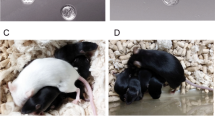Abstract
New herbicidal compounds (11 pyrimidine-diones, 3 benzoates and 1 sulfonamide) were found to be embryolethal but not teratogenic in rats. The range of the embryolethal dose varied from 0.2 to >200 mg/kg. This broad range enabled us to validate whether proposed in vitro teratogen tests can detect the embryolethality of these herbicides. The IC50 values (inhibition concentration 50%) for both differentiation and proliferation of midbrain and limb bud cells of rat embryos were determined and found to be above 50 μg/ml in all cases, confirming that the herbicides were not teratogenic. No correlation, however, was observed between the embryolethality in vivo and the activities in these cells. In order to test whether the potential to cause embryolethality could be predicted and detected as a general cytotoxic effect, the inhibition of colony forming ability in V79 cells was determined. The results indicated that cytotoxicity in V79 cells may be useful for preliminary testing of the embryolethal effect of herbicides.
Similar content being viewed by others
References
Flint OP (1987) An in vitro test for teratogens using cultures of rat embryo cells. In: Atterwill CK, Steele CE (eds) In vitro methods in toxicology. Cambridge University Press, Cambridge, pp 339–363
Flint OP, Boyle FT (1985) An in vitro test for teratogens: its application in the selection of non-teratogenic triazole antifungals. Concepts Toxicol 3: 29–35
Flint OP, Orton TC (1984) An in vitro assay for teratogens with cultures of rat embryo midbrain and limb bud cells. Toxicol Appl Pharmacol 76: 383–395
Guntakatta M, Matthews EJ, Rundell JO (1984) Development of a mouse embryo limb bud cell culture system for the estimation of chemical teratogenic potential. Teratogen Carcinogen Mutagen 4: 349–364
Hassell JR, Horigan EA (1982) Chondrogenesis: A model developmental system for measuring teratogenic potential of compounds. Teratogen Carcinogen Mutagen 2: 325–331
Horner SA, Fry JR, Clothier RH, Balls M (1985) A comparison of two cytotoxicity assays for the detection of metabolism-mediated toxicity in vitro: a study with cyclophosphamide. Xenobiotica 15: 681–686
Kistler A (1985) Inhibition of chondrogenesis by retinoids. Limb bud cell cultures as a test system to measure the teratogenic potential of compounds? In: Homburger F, Goldberg AM (eds) In vitro embryo-toxicity and teratogenicity tests. Concepts Toxicol, vol 3. Karger, Basel, pp 86–100
Kistler A (1987) Limb bud cell cultures for estimating the teratogenic potential of compounds. Validation of the test system with retinoids. Arch Toxicol 60: 403–414
Kistler A, Mislin M, Gehrig A (1985) Chondrogenesis of limb bud cells. Improved method and the effect of the potent teratogen retinoic acid. Xenobiotica 15: 673–679
Renault JY, Malcion C, Cordier A (1989) Limb bud cell culture for in vitro teratogen screening: validation of an improved assessment method using 51 compounds. Teratogen Carcinogen Mutagen 9: 83–96
Tsuchiya T, Tanaka A (1986) Effects of thiabendazole on the mouse limb-bud organ and cell culture. Toxicol Lett 30: 19–26
Tsuchiya T, Sekita S, Koyama K, Natori S, Takahashi A (1987a) Effect of chaetochromin A, chaetochromin D and ustilaginoidin A, bis (naphtho-γ-pyrone) derivatives, on the mouse embryo limb bud and midbrain cells in culture. Cong Anom 27: 245–250
Tsuchiya T, Hisano T, Tanaka A, Takahashi A (1987b) Effects of benzimidazoles on mouse and rat limb bud cells in culture. Toxicol Lett 38: 97–102
Tsuchiya T, Ishida A, Miyata N, Takahashi A, Kamiya S (1988) Effects of 3-tert-butyl-4-hydroxyanisole and its hydroquinone and quinone metabolites on rat and human embryonic cells in culture. Toxicol in Vitro 2: 291–296
Welsch F, Stedman DB (1984) Inhibition of metabolic cooperation between Chinese hamster V79 cells by structurally diverse teratogens. Teratogen Carcinogen Mutagen 4: 285–301
Wilk AL, Greenberg JH, Horigan EA, Pratt RM, Martin GR (1980) Detection of teratogenic compounds using differentiating embryonic cells in culture. In Vitro 16: 269–276
Author information
Authors and Affiliations
Rights and permissions
About this article
Cite this article
Tsuchiya, T., Bürgin, H., Tsuchiya, M. et al. Embryolethality of new herbicides is not detected by the micromass teratogen tests. Arch Toxicol 65, 145–149 (1991). https://doi.org/10.1007/BF02034942
Received:
Revised:
Accepted:
Issue Date:
DOI: https://doi.org/10.1007/BF02034942



